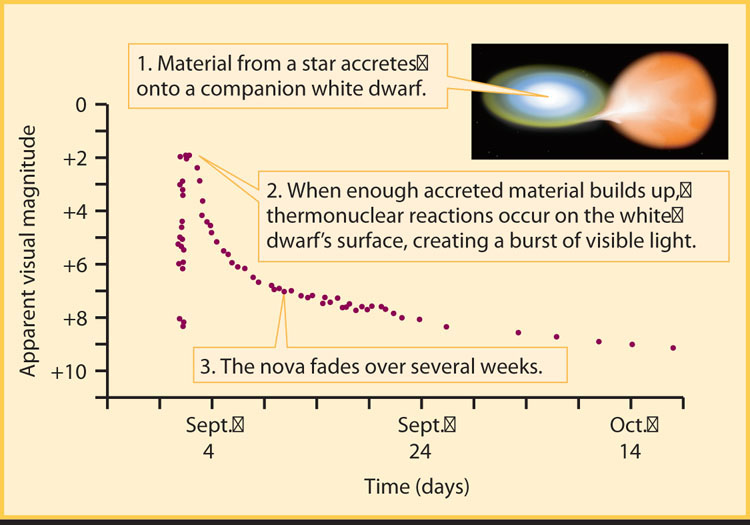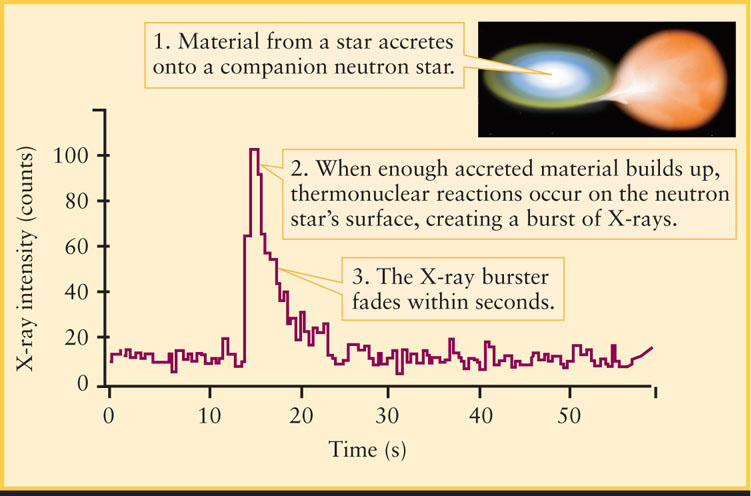20-12 Explosive nuclear processes on white dwarfs and neutron stars produce novae and bursters
Still other exotic phenomena occur when a stellar corpse is part of a close binary system. One example is a nova (plural novae), in which a faint star suddenly brightens by a factor of 104 to 108 over a few days or hours, reaching a peak luminosity of about 105 L⊙. By contrast, a supernova has a peak luminosity of about 109 L⊙.
Novae and White Dwarfs
In the 1950s, painstaking observations led to the conclusion that all novae are members of close binary systems containing a white dwarf. Gradual mass transfer from the ordinary companion star deposits fresh hydrogen onto the white dwarf (see Figure 19-21b for a schematic diagram of this sort of mass transfer).

Novae and thermonuclear supernovae both occur in close binary systems with a white dwarf, but a nova can recur while a supernova is a one-shot event
Because of the white dwarf’s strong gravity, this hydrogen is compressed into a dense layer covering the hot surface of the white dwarf. As more gas is deposited and compressed, the temperature in the hydrogen layer increases. When the temperature reaches about 107 K, hydrogen fusion ignites throughout the gas layer, embroiling the white dwarf’s surface in a nuclear detonation that we see as a nova (Figure 20-30).
CAUTION!
It is important to understand the similarities and differences between novae and the Type Ia supernovae that we described in Section 20-9 (see Figure 20-19). Both kinds of celestial explosions are thought to occur in close binary systems where one or both of the stars is a white dwarf. But, as befits their name, supernovae are much more energetic. A Type Ia supernova explosion radiates 1044 joules of energy into space, while the corresponding figure for a typical nova is 1037 joules. (To be fair to novae, this relatively paltry figure is as much energy as our Sun emits in 1000 years.) The difference is thought to be that in a Type Ia supernova, the white dwarf accretes much more mass from its companion, or a merger produces a larger mass. This added mass causes so much compression that nuclear reactions can take place inside the white dwarf and blow the white dwarf completely apart. In a nova, by contrast, nuclear reactions occur only within the accreted material on the surface.
Because the white dwarf itself survives a nova explosion, it is possible for the same star to undergo more than one nova. As an example, the star RS Ophiuchi erupted as a nova in 1898, then put in repeat performances in 1933, 1958, 1967, 1985, and 2006. By contrast, a given star can only be a supernova once.
592
X-ray Bursters and Neutron Stars
A surface explosion similar to a nova also occurs with neutron stars. In 1975 it was discovered that some objects in the sky emit sudden, powerful bursts of X-rays. Figure 20-31 shows the record of a typical burst. The source emits X-rays at a constant low level until suddenly, without warning, there is an abrupt increase in X-rays, followed by a gradual decline. An entire burst typically lasts for only 20 seconds, and the same object can repeat these bursts, although at irregular intervals. Sources that behave in this fashion are known as X-ray bursters. Several dozen X-ray bursters have been discovered in our Galaxy.

X-ray bursters, like novae, are thought to involve close binaries whose stars are engaged in mass transfer. With a burster, however, the stellar corpse is a neutron star rather than a white dwarf. Gases escaping from the ordinary companion star fall onto the neutron star. The energy released as these gases crash down onto the neutron star’s surface produces the low-level X-rays that are continuously emitted by the burster.
Most of the gas falling onto the neutron star is hydrogen, which the star’s powerful gravity compresses against its hot surface. In fact, temperatures and pressures in this accreting layer become so high that the arriving hydrogen is converted into helium by hydrogen fusion. As a result, the accreted gases develop a layered structure that covers the entire neutron star, with a few tens of centimeters of hydrogen lying atop a similar thickness of helium. The structure is reminiscent of the layers within an evolved giant star (see Figure 20-2), although the layers atop a neutron star are much more compressed, thanks to the star’s tremendous surface gravity.
When the helium layer grows to about 1 m thick, helium fusion ignites explosively and heats the neutron star’s surface to about 3 × 107 K. At this temperature the surface predominantly emits X-rays, but the emission ceases within a few seconds as the surface cools. Hence, we observe a sudden burst of X-rays only a few seconds in duration. New hydrogen then flows onto the neutron star, and the whole process starts over. Indeed, X-ray bursters typically emit a burst every few hours or days.
Whereas explosive hydrogen fusion on a white dwarf produces a nova, explosive helium fusion on a neutron star produces an X-ray burster. In both cases, the process is explosive, because the fuel is compressed so tightly against the star’s surface that it becomes degenerate, like the star itself. As with the helium flash inside red giants (described in Section 19-3), the ignition of a degenerate nuclear fuel involves a sudden thermal runaway. This is because an increase in temperature does not produce a corresponding increase in pressure that would otherwise relieve compression of the gases and slow the nuclear reactions.
Pulsars and X-ray bursters are just some of the intriguing phenomena associated with neutron stars. However, some of the most interesting objects of all—black holes—are created when there is so much matter that a neutron star cannot form. The gravity associated with a neutron star is so strong that the escape speed from it is roughly one-half the speed of light. But if a stellar corpse has a mass greater than 3 M⊙, so much matter is crushed into such a small volume that the escape speed actually exceeds the speed of light. Because nothing can travel faster than light, nothing—not even light—can leave this dead star. Its gravity is so powerful that it leaves a hole in the fabric of space and time. We take up this story of black holes in the next chapter.
CONCEPT CHECK 20-19
Why is a nova less luminous than a Type Ia supernova (which both involve white dwarfs)?
CONCEPT CHECK 20-20
Why does a Type Ia supernova only occur once for a given object, but novae and X-ray bursters can occur repeatedly from the same object?